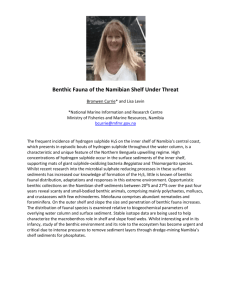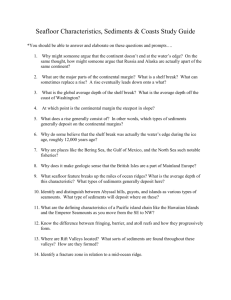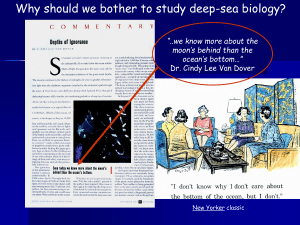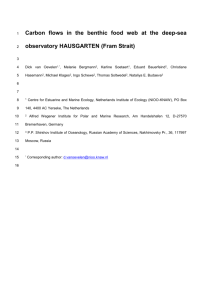Benthic Fauna of the Namibian Shelf Under Threat
advertisement
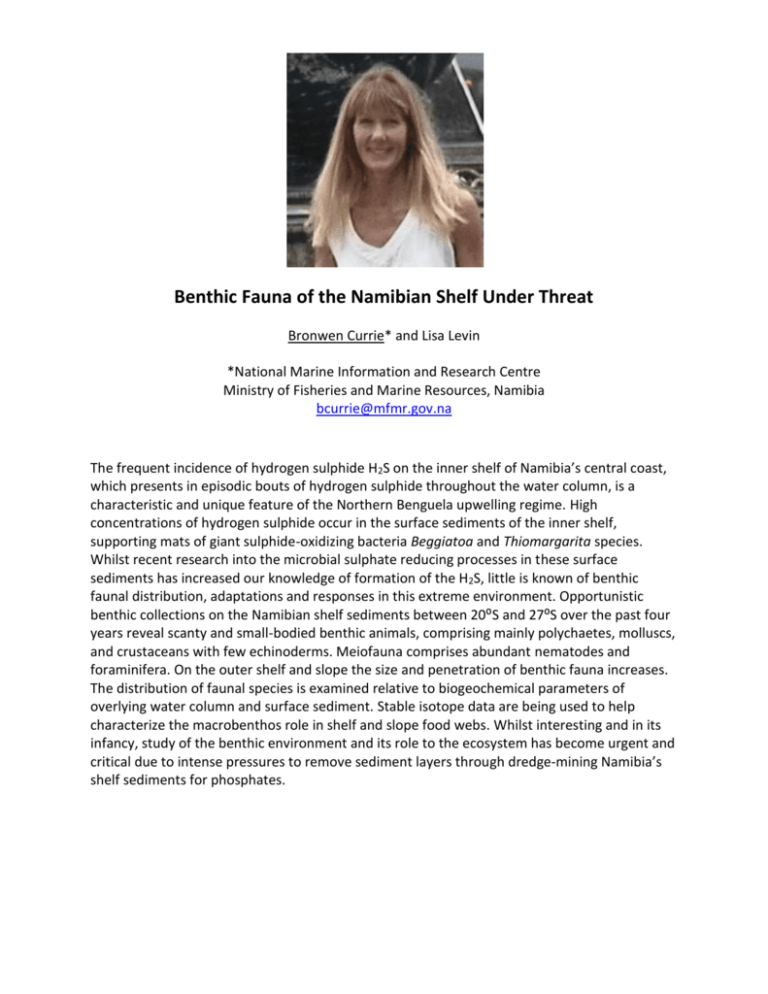
Benthic Fauna of the Namibian Shelf Under Threat Bronwen Currie* and Lisa Levin *National Marine Information and Research Centre Ministry of Fisheries and Marine Resources, Namibia bcurrie@mfmr.gov.na The frequent incidence of hydrogen sulphide H2S on the inner shelf of Namibia’s central coast, which presents in episodic bouts of hydrogen sulphide throughout the water column, is a characteristic and unique feature of the Northern Benguela upwelling regime. High concentrations of hydrogen sulphide occur in the surface sediments of the inner shelf, supporting mats of giant sulphide-oxidizing bacteria Beggiatoa and Thiomargarita species. Whilst recent research into the microbial sulphate reducing processes in these surface sediments has increased our knowledge of formation of the H2S, little is known of benthic faunal distribution, adaptations and responses in this extreme environment. Opportunistic benthic collections on the Namibian shelf sediments between 20⁰S and 27⁰S over the past four years reveal scanty and small-bodied benthic animals, comprising mainly polychaetes, molluscs, and crustaceans with few echinoderms. Meiofauna comprises abundant nematodes and foraminifera. On the outer shelf and slope the size and penetration of benthic fauna increases. The distribution of faunal species is examined relative to biogeochemical parameters of overlying water column and surface sediment. Stable isotope data are being used to help characterize the macrobenthos role in shelf and slope food webs. Whilst interesting and in its infancy, study of the benthic environment and its role to the ecosystem has become urgent and critical due to intense pressures to remove sediment layers through dredge-mining Namibia’s shelf sediments for phosphates. Comparative composition, diversity and trophic ecology of sediment macrofauna at vents, seeps and organic falls Angelo F. Bernardino *, Lisa A. Levin, Andrew R. Thurber, Craig R. Smith *Departamento de Oceanografia e Ecologia, Universidade Federal do Espírito Santo, Brasil angelofraga@gmail.com Sediments associated with hydrothermal venting, methane seepage and large organic falls such as whale, wood and plant detritus create deep-sea networks of soft-sediment habitats fueled, at least in part, by the oxidation of reduced chemicals. Biological studies at deep-sea vents, seeps and organic falls have looked at macrofaunal taxa, but there has yet to be a systematic comparison of the community-level attributes of sediment macrobenthos in various reducing ecosystems. Here we review key similarities and differences in the sediment-dwelling assemblages of each system with the goals of (1) generating a predictive framework for the exploration and study of newly identified reducing habitats, and (2) identifying taxa and communities that overlap across ecosystems. We show that deep-sea seep, vent and organicfall sediments are highly heterogeneous. They sustain different geochemical and microbial processes that are reflected in a complex mosaic of habitats inhabited by a mixture of specialist (heterotrophic and symbiont-associated) and background fauna. Community-level comparisons reveal that vent, seep and organic-fall macrofauna are very distinct in terms of composition at the family-level, although they share many dominant taxa among these highly sulphidic habitats. Stress gradients are good predictors of macrofaunal diversity at some sites, but habitat heterogeneity and facilitation often modify community structure. The biogeochemical differences across ecosystems and within habitats result in wide differences in organic utilization (i.e., food sources) and in the prevalence of chemosynthesis-derived nutrition. In the Pacific, vents, seeps and organic-falls exhibit distinct macrofaunal assemblages at broad-scales contributing to ß diversity. This has important implications for the conservation of reducing ecosystems, which face growing threats from human activities. Megafauna diversity in the Clarion-Clipperton Fracture Zone: preliminary data of the BIONOD project Antonina Rogacheva*, Dmitry Miljutin, Lénaïck Menot, Joëlle Galéron, Carsten Rühlemann *P. P. Shirshov Institute of Oceanology, Russian Academy of Sciences, Moscow, Russia Studies of biodiversity are a major priority in high seas areas where commercial mining is proposed. Megafaunal diversity was estimated based on extended series of deep-sea images taken with the SCAMPI photo and video sledge in the Clarion-Clipperton Fracture Zone (CCFZ) area, a manganese nodule region in the equatorial NE Pacific. Images were obtained in the German license area for the exploration of polymetallic nodules during the joint Franco-German cruise BIONOD onboard RV L’Atalante (Genavir, France) in March-May, 2012. In total, 3024 images were taken at four transects covering approximately 14,500 m2 of the seafloor. In total, 90 megafaunal species from 9 phyla were recognized. The most species-rich taxa were Holothuroidea (22 species), Porifera (16 species) and Anthozoa (12 species). Only 6 species were found at all four transects. The results of the BIONOD cruise were compared with data obtained at two previous cruises to the CCFZ area: the MANGAN cruise to the German license area in 2010 and the NODINAUT cruise to the French license area in 2004. At least 28 species (~30%) recorded in BIONOD were also found at one or both of the previous cruises. In total, 149 megafaunal species were recognized at these three cruises. The species accumulation curve based on species records on all the three cruises suggests that further investigations are critical. Nematode assemblage from deep-sea polymetallic nodule area of the Central Indian Ocean Basin Ravail Singh*, Miljutina Maria, Miljutin Dmitry, Pedro Martinez Arbizu, Ingole Baban *Senckenberg Meer, Deutsches Zentrum Marine Biodiversitatsforschung, D-26382 Wilhelmshaven, Germany. The Central Indian Ocean Basin (CIOB) is known as a important area for potential deep-sea polymetallic nodule mining. Studies of biodiversity are a major priority before the commercial mining will start. The present study is aimed to investigate the nematode assemblages inhabiting polymetallic nodule fields in CIOB. Samples were collected during the 39th cruise of RV “Akademic Boris Petrov” (2009) from the nodule poor and nodules rich areas using a box corer. The results of preliminary analysis (8 corers from 2 stations) reported mean density of nematode 7.6 inds/10 cm2. The nematodes were represented by 93 genera belonging to 28 families. Among families, Xyalidae (23%), Chromadoridae (20%), and Desmodoridae (10%) were dominant. The most abundant genera were Acantholaimus (8%), Desmoscolex (4%), and Daptonema (3%). The most species-rich genera was Acantholaimus. The dominant morphotype was Thalassomonhystera sp.2 (4%), followed by Acantholaimus sp.4 (3%) and Acantholaimus sp.3 (3%). The mean values of diversity indices were: H'=4.27, J'=0.89 d=6.43 and ES(51)=23.65. Several species belonging to the genera (Acantholaimus, Theristus, Caligocanna, and Capsula) display a broad distribution in the abyssal zone. They have been described previously from other regions and even other oceans. Present data show a big similarity with other abyssal areas in their composition of dominant genera and familes and in values of diversity indices, however the nematode density was significantly lower (p < 0.05). Dispersal abilities of hydrothermal vent animals in Indian Ocean inferred from mitochondrial DNA sequence Girish Beedessee*, Hiromi Watanabe, Tomomi Ogura, Satoshi Nakagawa, Kentaro Nakamura, Ken Takai ,Meera Koonjul, Daniel E.P Marie, Kensaku Tamaki *Mauritius Oceanography Institute, Quatre-Bornes, Mauritius. Dedicated to Late Prof.Kensaku Tamaki Dispersal ability is one of the main factors to maintain the species in spatially and temporally discrete environment of deep-sea hydrothermal vent fields. Dispersals of most animals in the mid-oceanic ridge systems are thought to be limited by geographical barriers such as trench, transform faults and microplates based on the population genetic analyses in the eastern Pacific vent fields. In the mid-oceanic ridge system in Indian ocean, the four hydrothermal vent fields, Kairei and Edmond fields near the triple junction, and Dodo and Solitaire fields in the Central Indian Ridge) have been discovered to date, and the phylogeographic analyses based on partial mitochondrial COI sequence was carried out for the four representative vent animals, Alviniconcha and scaly-foot gastropods, bythograeid crab Austinograea rodriguezensis, and alvinocaridid shrimp Rimicaris kairei, in these areas. Potentially high dispersal abilities, i.e. no genetic difference between several thousands of kilometers departed vent fields, were estimated for all the four analyzed species. The genetic diversities were relatively high in gastropods compared to the crustaceans, even in the swarmed Rimicaris shrimps. The dispersal strategies seemed to be different among the species, the present results on connectivity between the triple junction and the Central Indian Ridge vent fields may suggest strong physico-chemical factors independent to the ecological characteristics of the animals.
